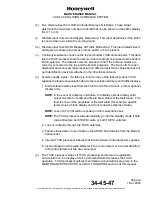
Page 48
1 Dec 2003
34-45-4
7
MAINTENANCE MANUAL
CAS-100 COLLISION AVOIDANCE SYSTEM
Use or disclosure of information on this page is subject to the restrictions in the proprietary notice of this document.
(g) The TCAS processor calculates the correct resolution advisory to keep or make sure
of the safe separation between own and threat category aircraft. The TCAS
processor then outputs resolution advisory data on the ARINC 429 buses to the
TA/VSI or RA/VSI units. RA traffic symbol position and alert data is output on the
ARINC 429 data bus to the TA/VSI or PPI display unit. Last, resolution advisory alert
voice messages and alert outputs are sent to the cockpit audio system for optional
tone generators and/or lamps.
(h) The TCAS processor outputs TA traffic symbol position and alert data on the ARINC
429 data bus to the TA/VSI or PPI display for the traffic advisory category aircraft. The
processor also outputs traffic advisory alert voice messages and alert output for
optional tone generators and/or lamps to the cockpit audio system.
(i)
The TCAS processor outputs proximity or nonthreat traffic symbol position data on the
ARINC 429 data bus to the traffic advisory display for proximity and nonthreat
category aircraft. (The voice alerts are not supplied for proximity or nonthreat
category aircraft.)
(j)
The TCAS processor establishes a coordination data link with the threat category
aircraft that are also TCAS equipped. The TCAS processor transmits coordination
messages and receives coordination messages from the threat aircraft transponders
through own TCAS antennas. Once the TCAS equipped threat aircraft has sensed
own aircraft as a threat, the same procedure is started through own Mode S
transponder. A full two-way coordination data link is established. The coordination
data assure nonconflicting maneuvering between TCAS-equipped aircraft that are
threats to each other.
(k)
During each TCAS 1030 MHz transmission on the directional or omni antenna, the
TCAS processor supplies a suppression pulse to other L-band equipment on own
aircraft.
(l)
The TCAS processor decreases fruit and synchronous interference by the following
interference limiting procedures:
1 An ATCRBS P2 sidelobe suppression pulse is transmitted as an P2 pattern on the
directional antenna to control the effective beam width.
2 A sequence of ATCRBS interrogations are transmitted at different power levels
(whisper-shout levels). These whisper-shout levels divide the adjacent airspace
into the range segments. The maximum number of whisper-shout levels (24) are
used when interrogating in the forward direction on the directional antenna.
3 Interrogating more than once to check reply validity.
4 Transmitting a P2 ATCRBS suppression pulse in Mode S interrogation
transmissions.
5 Transmitting a P4 Mode S suppression pulse during ATCRBS interrogation
transmissions.
















































